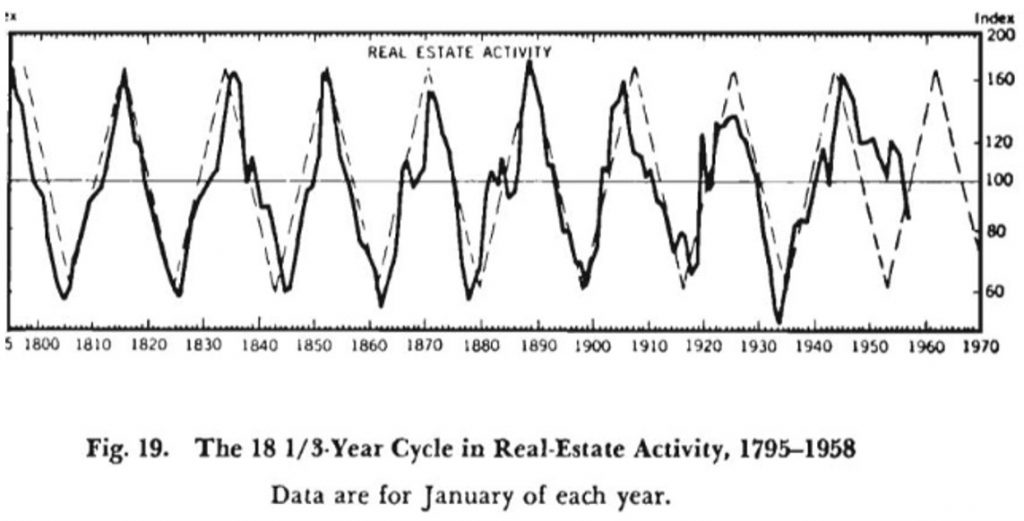‘As above, so below…’
Hermes Trismegistus
‘Those who cannot remember the past are condemned to repeat it.’
George Santayana
It’s 1931, the US is in a deep depression. The US government wanted to know the cause…
So, they set Edward Dewey the task, to do just that. He was the chief analyst in the commerce department. He had all the resources at his disposal.
But his research never came to a definite cause. He did notice though, a boom/bust repeat. And it led Dewey into a lifelong study of cycles.
In his book Cycles: The Mysterious Forces that Trigger Events, published in 1971, we saw some of the fruits from that research.
He publishes in that book some of the research work of Roy Wenzlick. Now Wenzlick is a name you may not have heard of, so let me tell you. He wrote The Coming Boom in Real Estate, published in 1936.
It accurately forecast what was to come in the decades ahead.
Note: this this book was published in the 1930s. It’s the very bottom of the Great Depression. It would have been a really brave thing to call a coming boom.
But history shows he was exactly right.
Here’s a graph taken from Dewey’s cycles book, drawing on the work of Roy Wenzlick. It measured real estate activity going back to 1800…

That repeating of the cycle cannot be the result of chance. It’s far too regular to be denied or ignored.
As to why it repeats every 18-and-a-third years, you might find my quotes at the start useful. I leave that with you to follow through. And whilst the timing of the cycle is a matter for debate, the cause of the boom/bust cycle is clear.
Dewey’s research couldn’t find the cause. And most analysts put the Great Depression down to the 1929 stock market crash.
But what was the real cause that lay behind the 1929 crash and Great Depression? [openx slug=inpost]
House prices the root cause of boom/bust cycles
Well, if you want to dig a little, you may come to find it was (and always has been) a speculation in an ever-rising land price.
The new technology of the mass produced motor car opened up vast areas of land to suburban and rural housing. Land price boomed and everyone got into the act.
It was no different to the railroad boom before it. That also opened up vast areas for land speculation. Wherever the railroads went, land price was sure to rise.
As an aside, this is how the railroad road barons got so rich. The rail barons knew the money wasn’t in the fares. The real money was in buying up all the land, wherever the railroads were to go.
This is the way of things. It’s always the same old.
New technology, better ways of doing things, all feed into a rising land price. And then people start to speculate in it. And there’s your cycle.
And whilst governments tax productive effort and enterprise, and leave land untaxed, we must get a cycle.
It creates a world where heavily borrowed voters and governments alike are desperate to keep land prices high, at least to stop house price falls. Our recent election showed this in sharp relief.
Most put the boom/bust cycle down to interest rate manipulations. Or, easy credit. But easy credit is not the root cause, it only adds fuel to the fire.
Just like the railroad boom of the 1870–80s, the car boom of the 1920s and the boom/bust of 2008, it’s always the speculation in land price at root.
I’m not pushing a barrow with this. But just to show you for your own investing, you can be pretty sure this cycle will repeat whilst land has a price.
Whether it’s the 1890s, 1929 or 2008, the underlying cause is always the same. That’s why the financial reforms put in place after 2008 are pointing towards another cycle. Because it wasn’t a financial crisis in the first place.
Nothing has changed. It is still the same old system.
The month of May was a good one for Aussie property.
On top of prospective interest rate cuts and easing APRA regulations, home loan applications to Australia’s biggest lender also hit a 10-month high last month.
None of that suggests collapse.
As Wenzlick and others have discovered, the cycle just has a way of repeating. His work clearly showed this.
And while the timing of the cycle is a matter of debate, the cause doesn’t seem to be. And as we never get to the underlying cause, you can have confidence that the cycle is likely to repeat.
Regards,
Terence Duffy





Terence Duffy is an analyst and chartist, specialising in researching economic trends and cycles. His primary focus is housing and land affordability. But you can also depend on him to offer his unique analysis of stock market charts. As Terence will show you, the charts often forecast, well in advance, the good or bad news to come.